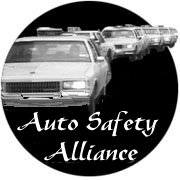A publication by the Auto Safety Alliance

| Driver
Alert
A publication by the Auto Safety Alliance |
 |
| Volume 1 | November 1997 | Issue 1 |
|
Drivers need antilock brake training by Robert Fisher
|
Despite the fact that antilock braking
systems (ABS) were designed to reduce crash rates, automobile insurers
such as USAA and Allstate have announced that discounts for ABS equipped
vehicles will cease.
Why? Research shows no substantial difference in claims between vehicles equipped with ABS and those without. With ABS, drivers are not supposed to pump the brake. The brake pedal of an ABS-equipped vehicle behaves quite differently when ABS engages. A loud grating sound and rapid brake pedal pulsation often accompanies the braking action with ABS, which may alarm the driver. When this occurs, safety experts theorize that some drivers assume that something has gone wrong with their brakes. These drivers then begin to pump the pedal or simply lift off the brake pedal. This defeats the ABS system. When anyone buys a vehicle with an ABS system, they should practice using ABS. Jerking the wheel while using antilock brakes can send a car swerving
violently off course. Drivers with anitilock brakes should practice
emergency braking and steering before an emergency.
|